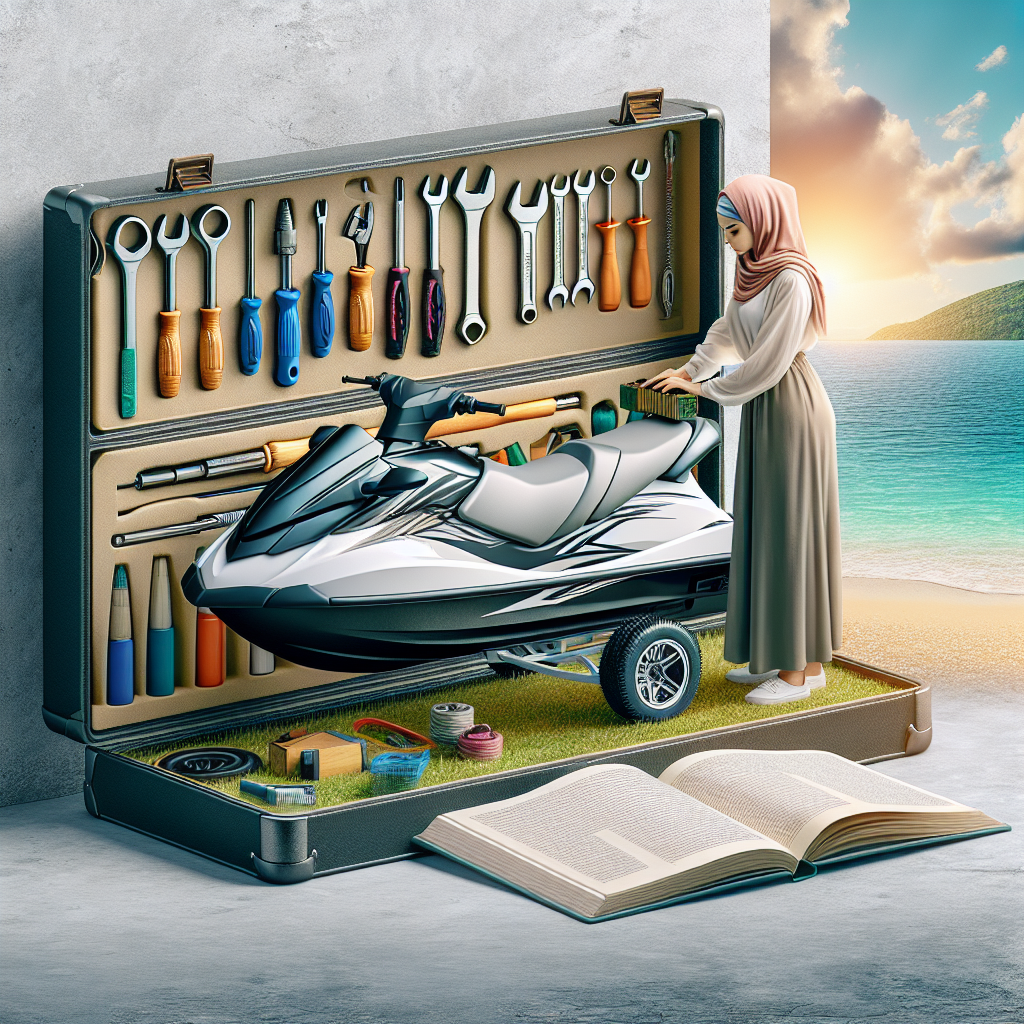Jet Ski Maintenance and Care Tips

If you’re a jet ski enthusiast, you know that proper maintenance and care are essential for ensuring your watercraft’s longevity and performance. From regular cleaning and inspections to engine maintenance and storage tips, taking care of your jet ski is a responsibility that shouldn’t be overlooked. In this article, we’ll provide you with some insightful tips and tricks on how to maintain and care for your jet ski, helping you make the most out of your thrilling rides on the water. So, whether you’re a seasoned jet skier or just starting out, read on to discover how you can keep your jet ski in top-notch condition and enjoy endless hours of exhilarating fun. And if you’re looking for a reliable place to rent a jet ski, we recommend checking out A2Z Powersport, the watersport experts located in Orange Beach, AL. They offer a wide selection of jet skis for rent and are committed to providing exceptional customer service.
Jet Ski Maintenance and Care Tips
Jet skis are a thrilling way to enjoy the water and experience the thrill of speed and freedom. However, like any other vehicle, they require regular maintenance and care to ensure optimal performance and safety. Whether you are a seasoned jet ski enthusiast or a beginner, it is important to follow a few key maintenance and care tips to keep your jet ski in top shape. In this article, we will explore various aspects of jet ski maintenance and provide you with comprehensive tips to help you maintain your jet ski properly.
Regular Maintenance
Regular maintenance is essential for keeping your jet ski in excellent condition and preventing any potential issues that may arise. By incorporating a few simple inspections into your routine, you can catch any problems early on and address them before they develop into more significant and costly repairs.
Inspecting the Hull
A jet ski’s hull is its outer shell, and it is crucial to regularly inspect it for any damage, cracks, or signs of wear and tear. Check for any scratches, dents, or cracks in the fiberglass or plastic hull. Any damages should be repaired promptly to prevent further deterioration and maintain the performance and safety of your jet ski.
Checking the Fuel System
The fuel system is another critical component of your jet ski that requires regular attention. Start by inspecting the fuel lines for any signs of leaks, cracks, or loose connections. Ensure that all clamps and fittings are secured properly. Additionally, it is important to regularly replace the fuel filter to ensure that your engine receives clean fuel and prevent any clogs that may hinder performance.
Examining the Engine
The engine is the heart of your jet ski, and it is vital to keep it in optimal condition. Regularly inspect the engine for any signs of oil leaks, loose bolts, or damaged components. Check the oil levels and change the oil according to the manufacturer’s recommendations. Additionally, keep an eye on the spark plugs and replace them if necessary to maintain proper combustion and ensure smooth operation.
Inspecting the Propulsion System
The propulsion system, which includes the impeller and jet pump, is responsible for propelling your jet ski through the water. Inspect the impeller regularly for any signs of damage such as bent or missing blades. Clean any debris that may have accumulated in the jet pump intake to ensure proper water flow. A well-maintained propulsion system will provide better acceleration and maneuverability, enhancing your overall jet ski experience.
Testing the Electronics
Modern jet skis often come equipped with various electronic components, including gauges, GPS systems, and radios. It is crucial to regularly test these electronics to ensure they are functioning correctly. Check the battery voltage, inspect the wiring for any signs of damage, and verify the functionality of all electronic components. Address any issues promptly to avoid any potential safety hazards while you’re out on the water.
Preventive Measures
In addition to regular maintenance, there are several preventive measures you can take to prolong the life of your jet ski and ensure trouble-free operation. By implementing these simple steps, you can significantly reduce the risk of encountering any mechanical or performance issues.
Using a Cover
One of the easiest and most effective ways to protect your jet ski from the elements is by using a cover. A quality cover will shield your jet ski from direct sunlight, rain, dust, and other environmental factors that can cause damage over time. Choose a cover specifically designed for your jet ski’s make and model to ensure a proper fit and maximum protection.
Flushing the Engine
After each use, it is essential to flush the engine with fresh water to remove any salt, sand, or debris that may have entered the system during your ride. Connect a flushing attachment to the water intake and allow clean water to circulate through the engine for a few minutes. Flushing the engine after each use will help prevent corrosion, improve performance, and prolong the life of your jet ski.
Keeping it Clean
Regular cleaning is crucial to maintain the appearance and functionality of your jet ski. Rinse off any saltwater, sand, or grime from the exterior using fresh water. Use a mild soap and a soft brush to clean the hull, deck, and other surfaces. Avoid using harsh chemicals or abrasive materials that could scratch or damage the finish. Cleaning your jet ski regularly will not only keep it looking pristine but also help prevent corrosion and the buildup of marine growth.
Using Fuel Stabilizer
If you plan on storing your jet ski for an extended period, it is important to add a fuel stabilizer to the tank to prevent the fuel from breaking down and causing damage to the engine. Fuel stabilizers inhibit the oxidation of fuel, preventing gum and varnish buildup that can clog the fuel system. Follow the manufacturer’s instructions when using a fuel stabilizer and ensure the stabilizer is evenly distributed throughout the fuel tank.
Winterizing Your Jet Ski
If you live in an area with cold winters or plan to store your jet ski during the colder months, it is crucial to properly winterize it to avoid potential damage from freezing temperatures. Winterizing your jet ski involves a series of steps that will protect the engine, fuel system, and other components from the harsh conditions of winter.
Preparing the Fuel System
Before winterizing your jet ski, it is important to stabilize the fuel and drain any excess water from the fuel system. Start by adding a fuel stabilizer to the tank to prevent the fuel from breaking down during the storage period. Run the engine for a few minutes to allow the treated fuel to circulate through the system. Next, use a fuel line or drain plug to remove any excess water that may have accumulated in the fuel system. This will prevent the water from freezing and potentially damaging the system.
Draining the Water
To protect your jet ski’s engine and other water-sensitive components, it is essential to drain any water that may be present. Begin by removing the drain plugs from the hull and the jet pump area. Allow any accumulated water to fully drain out. Be thorough in this process to avoid any potential damage from frozen water during storage.
Fogging the Engine
Fogging the engine is a critical step in winterizing your jet ski. Fogging involves introducing a fogging oil to the engine’s air intakes while the engine is running. This coats the internal components with a protective layer of oil, preventing corrosion and ensuring proper lubrication during storage. Follow the manufacturer’s instructions when using a fogging oil and ensure that the engine is evenly coated.
Storing in a Dry Place
Once you have completed all the necessary steps for winterizing your jet ski, it is important to store it in a dry and secure location. A dry garage, storage unit, or covered area is ideal for protecting your jet ski from the elements. Ensure that the storage location is free from moisture and rodents that could cause damage. Cover your jet ski with a breathable cover to provide added protection while allowing air circulation.
Safety Precautions
While it is essential to properly maintain and care for your jet ski, safety should always be a top priority. Adhering to a few basic safety precautions will not only protect you but also prolong the life of your jet ski.
Wearing a Life Jacket
Always wear a properly fitting Coast Guard-approved life jacket when operating a jet ski. Life jackets are essential in case of an accident or unexpected immersion in the water. Choose a life jacket that is designed for jet skiing and provides maximum comfort and buoyancy. Ensure that all passengers on your jet ski are also wearing appropriate life jackets.
Using a Kill Switch
A kill switch is a safety device that automatically shuts off the engine if you become separated from the jet ski. It is important to always attach the kill switch lanyard securely to your person or life jacket. In the event that you fall off the jet ski, the kill switch will prevent the engine from running without you, reducing the risk of accidents and injuries.
Avoiding Excessive Speed
While jet skis are designed for speed and agility, it is important to operate them responsibly and cautiously. Avoid excessive speeding and keep a safe distance from other watercraft, swimmers, and stationary objects. Always adhere to local rules and regulations regarding speed limits and restricted areas.
Maintaining Safe Distances
Maintaining a safe distance from other watercraft can help prevent collisions and accidents. Be aware of your surroundings and give other boaters, swimmers, and jet skiers a wide berth. Respect the right of way and avoid crowded areas to minimize the risk of accidents and maintain a safe and enjoyable experience on the water.
Trailer Maintenance
Proper maintenance of your jet ski trailer is also crucial in ensuring a safe and hassle-free experience. regularly inspecting and maintaining your trailer will help prevent any issues while transporting your jet ski to and from the water.
Inspecting Tires and Bearings
Check the tires on your trailer for signs of wear, adequate tread, and proper inflation. Replace any worn or damaged tires and ensure that the lug nuts are securely tightened. Additionally, inspect the wheel bearings for any signs of wear, rust, or damage. Lubricate the bearings regularly to ensure smooth operation and prevent any damage that may occur due to excessive heat or friction.
Checking Lights and Wiring
A well-functioning lighting system on your trailer is essential for safety and legal compliance. Regularly check all lights, including brake lights, turn signals, and reflectors, to ensure they are in proper working condition. Clean any dirt or debris that may be obstructing the lights and inspect the wiring for any signs of damage or loose connections. Repair or replace any faulty lights or wiring immediately.
Greasing the Trailer Hitch
Properly greasing the trailer hitch is crucial for ensuring smooth operation and preventing unnecessary wear and tear. Apply high-quality waterproof grease to the trailer hitch ball and coupler to minimize friction and allow for easy attachment and detachment. Regularly inspect the hitch for any signs of damage, cracks, or excessive wear. Repair or replace any faulty components to maintain the safety and integrity of the trailer hitch.
Battery Maintenance
The battery is an essential component of your jet ski’s electrical system, and proper maintenance is necessary to ensure reliable starting power and optimal performance.
Checking Battery Connections
Regularly inspect the battery terminals for any signs of corrosion, loose connections, or damaged wires. Clean the terminals and cable ends with a wire brush and ensure they are securely tightened. Apply a thin layer of dielectric grease to protect against corrosion and oxidation.
Charging the Jet Ski Battery
If your jet ski is not in use for an extended period, it is important to keep the battery properly charged to maintain its health. Use a battery charger specifically designed for marine batteries and follow the manufacturer’s instructions for charging. Avoid overcharging the battery and ensure that it remains at an optimal level throughout the storage period.
Jet Ski Cleaning
Proper cleaning is not only essential for maintaining the appearance of your jet ski but also for preventing corrosion and maintaining its performance.
Cleaning the Exterior
Regularly wash the exterior of your jet ski to remove any saltwater, dirt, or grime that may have accumulated. Rinse the hull and deck with fresh water to remove any debris. Use a mild soap and a soft brush or sponge to clean the surfaces, and rinse thoroughly afterward. Avoid using abrasive materials that could scratch or damage the finish.
Flushing the Engine
Flushing the engine is not only an important step in regular maintenance but also a crucial part of post-ride cleaning. Connect a flushing attachment to the water intake and allow clean water to circulate through the engine for a few minutes. This will remove any salt, sand, or debris that may have entered the engine during your ride.
Cleaning the Seat and Interior
The seat and interior of your jet ski can accumulate dirt, sunscreen, and other residues over time. Use a mild soap and water solution to clean the seat and other interior surfaces. Gently scrub the surfaces with a soft brush or sponge, and rinse thoroughly. Avoid using harsh chemicals or abrasive materials that could damage the upholstery or other interior components.
Jet Ski Storage
Proper storage is essential for protecting your jet ski from the elements and ensuring its longevity. Follow these tips to store your jet ski correctly.
Choosing a Suitable Storage Location
Select a storage location that is dry, secure, and free from extreme temperatures and humidity. A garage, storage unit, or covered area is ideal for protecting your jet ski from the elements. If storing your jet ski outdoors, choose a quality cover specifically designed for your jet ski’s make and model to provide maximum protection.
Properly Securing the Jet Ski
To prevent any movement or damage during storage, it is important to secure your jet ski properly. Use tie-down straps or ropes to secure the jet ski to the trailer or a stationary object. Ensure that the jet ski is stable and cannot be moved or tipped over while in storage.
Covering the Jet Ski
Using a quality cover is vital for protecting your jet ski from dust, sun exposure, and other environmental factors. Choose a cover that is breathable and specifically designed for your jet ski’s make and model. Ensure that the cover fits snugly and covers the entire jet ski, including the handlebars, seat, and other exposed parts.
Jet Ski Troubleshooting
While proper maintenance and care can significantly reduce the risk of encountering issues with your jet ski, it is important to be prepared for any potential problems that may arise. Here are a few common troubleshooting tips for some common jet ski issues.
Engine Won’t Start
If your jet ski’s engine fails to start, check the battery connections to ensure they are secure and clean. Verify that the battery has enough charge by using a battery tester or charger. Inspect the spark plugs for any signs of damage or wear and replace them if necessary. If the engine still won’t start, it may be necessary to consult a professional technician for further diagnosis and repair.
Loss of Power
Loss of power can be caused by various factors, including clogged fuel filters, dirty carburetors, or a malfunctioning exhaust system. Start by inspecting the fuel filters and replacing them if necessary. Clean the carburetors and check for any blockages or debris. If the issue persists, it is recommended to seek the assistance of a trained technician to identify and resolve the problem.
Overheating Issues
Overheating can occur due to a variety of reasons, including low coolant levels, a malfunctioning water pump, or a blocked cooling system. Check the coolant levels and top up if necessary. Inspect the water pump for any signs of damage or wear and replace it if needed. Clean any debris or blockages in the cooling system. If the issue persists, it is advisable to consult a professional technician to diagnose and resolve the problem.
Steering Problems
If you experience steering problems, such as difficulty turning or sudden loss of control, check the steering system for any loose or damaged components. Ensure that the steering cable is properly connected and lubricated. Inspect the handlebars for any cracks or damage, and replace them if necessary. If the issue persists, seek professional assistance to diagnose and resolve the problem.
In conclusion, jet ski maintenance and care are key to ensuring that your jet ski operates smoothly, performs optimally, and provides you with years of enjoyment on the water. By following the comprehensive tips provided in this article, you can keep your jet ski in top shape and minimize the risk of encountering any issues or breakdowns. Remember to always adhere to safety precautions and consult professional technicians for any complex repairs or issues. Whether you are a seasoned jet ski enthusiast or a beginner, proper maintenance and care will help you make the most of your jet ski experience. So, get out there, have fun, and enjoy the thrill of jet skiing while knowing you are taking good care of your investment. And for all your jet ski rental needs, consider renting from the watersport experts at A2Z Powersport located in Orange Beach, AL, at the Fort Morgan Marina. Contact them at (954) 296 1862 or bookings@a2zpowersport.com to book your next adventure today!










